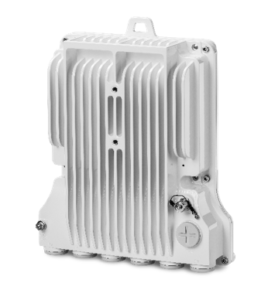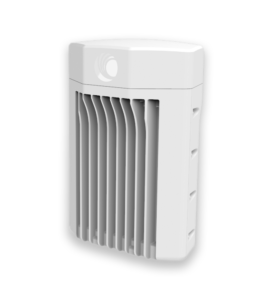The City of Aurora is a Home Rule Municipality located in Arapahoe, Adams, and Douglas counties, Colorado. Aurora lies immediately east of Denver. It is one of the principal cities of the Denver–Aurora–Lakewood, CO Metropolitan Statistical Area and a major city of the Front Range Urban Corridor.
The City trusts Castle Rock Microwave to help them overcome their wireless connectivity challenges. As a result, they turned to CRM when they were looking to upgrade connectivity at several community locations in late 2020.
Castle Rock Microwave suggested wireless solutions from Cambium Networks in 60 and 80GHz. These millimeter wave frequencies are ideal for achieving fiber-like speeds at a fraction of the cost of building new fiber infrastructure.
We recommended the PTP850E for 80GHz and cnWave v5000 and v3000 for 60GHz. The PTP850E is an ultrahigh capacity, all-outdoor backhaul that delivers up to 20 Gbps capacity. The cnWave uses Terragraph, Facebook’s new terrestrial connectivity technology.

PTP850E

cnWave v5000

cnWave v3000
Terragraph opens up a new way to use the large amounts of unlicensed spectrum available in the 60 GHz millimeter Wave band, using a mesh architecture that can be used for many FWA, backhaul, smart cities and IoT use cases. With the increase in demand for gigabit connectivity and the availability of commercial equipment, Terragraph has become a hot technology, with the first large commercial deployments expected in 2021.
To find out more about Terragraph and the opportunities it offers to service providers, cities and enterprises, register here to receive the report that will be available soon, or download the interviews that will be part of the report as they become available.
Photo by Vlada Karpovich on Pexels.com
In 2020, rural telcos that provide wireless internet access have seen many rapidly developing events that have impacted their businesses. Instantaneous increases in demand due to COVID, RDOF applications, CBRS Auction and CARES Act money/grants have been pushing rural telcos to optimize network performance and capacity. In this article, I will address some of the performance issues rural telcos with broadband services are seeing and solutions to optimize wireless networks.
This increased demand has left many providers struggling to keep up to their overtaxed networks. In addition, they are having problems providing reliable service and their customers are starting to look for better alternatives.
In a recent article , Mike Dano states, “As office workers, students and others continue to seek shelter at home from COVID-19, demand for speedy and reliable Internet service appears to be at an all-time high. That demand is beginning to have serious effects on the nation’s telecommunications providers.” “Capgemini recently surveyed 6,300 US consumers and found that almost half (48%) felt their Internet connections didn’t meet their needs. The firm also found that customers are increasingly looking at their connection’s flexibility and network speeds, rather than just the reliability and price.”
With so much expansion occurring within internal networks and competitors’ networks, interference can slowly creep in degrading performance.
New users and greater capacity demands are now exposing issues with bandwidth management. Furthermore, poor bandwidth management from inefficient design practices decreases available bandwidth and decrease capacity in the distribution network.
There are solutions, but there are often tradeoffs as well. The decisions on performance are being driven by market demand and existing capacity. With rapid expansion of user expansion and bandwidth demand, your wireless access points and network can quickly become overburdened. Start with an audit of RF performance by an RF expert to see which problems you are experiencing.
One solution is using more directional antennas at access points. This will help performance by:
Another solution is using smaller cells or micro PoPs. This can increase capacity, improving the user experience. Each access point is limited the least common denominator of capacity its users are receiving. As a result, wide ranges of distances from the access points can play havoc on performance. Therefore, tighter variances and shorter distances will help set customer expectations.
Adding capacity is an obvious solution. 25/3 is no longer the real standard, users are now demanding 100’s of Megs or even Gigabit capacity. There is a new disruptive carrier class PTP option pushing multiple gigabits per second. And it is one of the most cost-effective solutions in terms of cost per megabit per second per mile. This product provides the highest capacity in a single transceiver radio with 2.5Gbps (single radio – 2x112MHz channels) or 1.5Gbps (single radio – 2x80MHx channels) at 4096 QAM. For more information on implementing this system, please visit our Case Study with South Park Telephone Company.
For the distribution network, implementing massive Multi-User MIMO or MU MIMO solutions will provide greater access to users and capacity. Many carriers are using less robust, standard MIMO solutions and are reaching user density thresholds. Accordingly, they need a technology leap to support more users at higher capacity. Cambium’s PMP450m (cnMedusa) is a high-capacity multi-point solution that can provide more than 400 Mbps actual usable throughput per sector, and communicate with up to seven Subscriber Modules simultaneously. With 8×8 MU MIMO it provides 4x more spectrum efficiency than any other vendor. It also impressive Near or Non-LOS capabilities as well for more flexible installations.
Purchasing microwave equipment is a long-term decision with implications on future needs, sustainability, and total cost of ownership. A few years ago, Brett Bonomo wrote an article on this topic that covers key questions to ask including:
For more detail visit the complete article at https://castlerockmicrowave.com/selecting-the-right-radio
Would you feel more comfortable hearing from others when evaluating technology? Great, there is a great Facebook page that hosts over 10,000 members where you will likely find answers to your many questions from companies much like yours.
CBRS (Citizens Broadband Radio Systems) is now being considered by many telcos for a last mile solution. If you are not familiar with this newly available spectrum (3550-3650MHz), here is a quick article on CBRS
What are some of the key advantages of CBRS?
With fewer issues of interference and more flexible antenna locations this means happier customers and fewer truck rolls to tweak your network.
Companies operating CBRS networks need to employ someone with a CPI, either directly or via consultancy. There are many online training courses to get certified. Make sure the training course registers you in the WinnForum CPI database and send your credentials automatically.
Castle Rock Microwave can assist you with a coverage comparison analysis or try it yourself if you are familiar with LINKPlanner (Cambium Networks) or Pathloss software.
Castle Rock Microwave is a turnkey, regional system integrator for microwave backhaul, fixed wireless broadband and WI-FI solutions for Rural Telcos, Utility Companies and Public Safety agencies. We view your wireless system as an integral part of your operation and create holistic RF designs with your entire systems, sustainability, and future business goals in mind. We are vendor agnostic and work with our clients in choosing the best solution for performance, maintainability, and budget in mind. Call us for:
Current market conditions are creating opportunities for rural telcos to expand their users and networks and in some cases with substantial grants. Wise long-term investments in the correct gear will separate the leaders from the competition. Make sure your designs are considering all the factors when deploying or optimizing your wireless network and contact Castle Rock Microwave for help at sales@castlerockmicrowave.com or call 303-358-7039.
The impact of wind turbines on microwave radio paths is a bit of a mystery. It’s often misunderstood. In this blog post I’ll provide a couple planning tips and some useful reference material. My goal is helping you make good decisions about how to plan for a successful coexistence of microwave paths and wind turbines.
I planned many microwave paths near wind farms containing individual wind turbines. I also investigated performance issues caused by the these spinning behemoths near microwave paths. When it comes to planning microwave paths over rural, flat terrain, you need to consider the possibility that wind turbines could be present. In addition, you need to have a plan if they are in the vicinity of the proposed radio sites. I found that following the recommendations below made it a straightforward planning exercise.
The presence of wind farms is obvious if you’re familiar with an area or personally involved in surveying sites. However, so much preliminary work is done from a distance and often without intimate knowledge of the landscape. The USGS is an excellent resource to identify wind turbines and wind farms. They even provide a Google Earth .KMZ file which helps quickly identify any wind turbines that might obstruct the microwave path.
There are three main considerations to ensure a successful outcome when deploying microwave in the presence of wind turbines:
The impact of the first two criteria is generally manifested as reduced received signal level (RSL) from the designed plan. This generally degrades throughput performance and sometimes causes bit errors. The third item, reflections caused by the moving blades, will generally be manifested by increased bit errors and perhaps varying RSL. Don’t let the fact that the blades are seemingly non-conductive fool you. They likely contain trace amounts of copper to assist in lightning protection.
Over the past twenty years a fairly substantial amount of empirical data was collected to quantify the impact of wind turbines on analog wireless systems in the TV broadcast and radar bands. Comparatively less work has been done to collect similar data for digital transmissions in the microwave bands. However, paths can be planned with confidence using the guidance indicated in these documents; Wind Farms and Microwave Links – Harvey Lehpamer and Fixed Link Wind-Turbine Exclusion Zone Method – D F Bacon. These documents describe the general rules for exclusion zones around the path and distill it down to simple parameters. Harvey Lehpamer’s recommendation form his paper entitled Wind Farms and Microwave Links generally recommends the following:
These are approximations that vary with the path distance, frequency of the radios in the path, and size of the wind turbine
Have you ever suspected interference from a wind turbine? Please take a second and tell us what you did to resolve the problem below. Don’t forget to sign up for notification of future posts.
"We guarantee your system will work as designed for the first year, or we'll make it right."
Please CLICK HERE to read our full Terms & Conditions